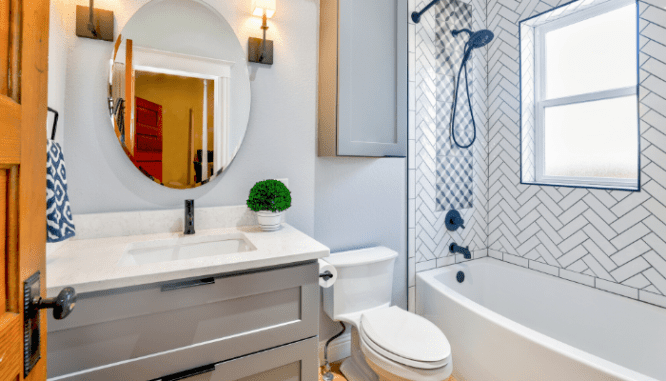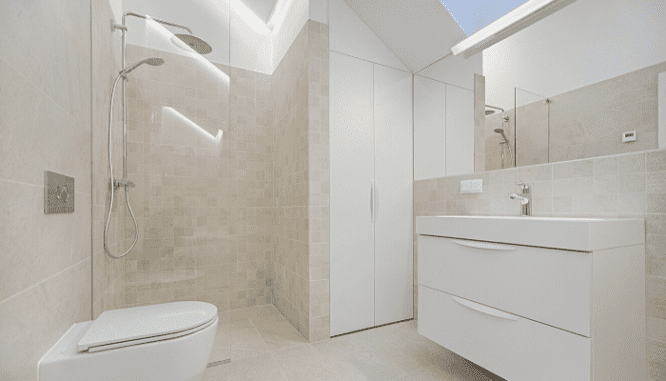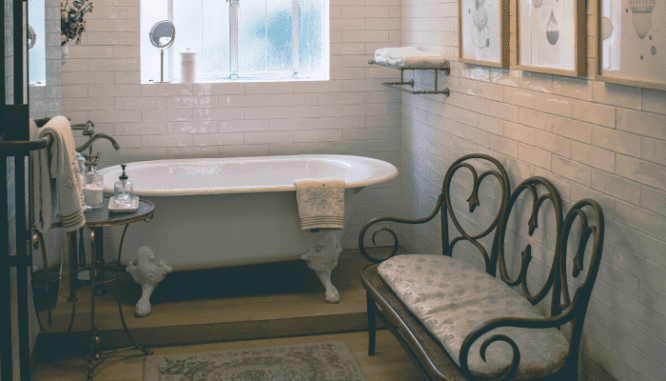What Is a Half Bath? The Mystery Behind Fractional Bathrooms, Solved
- Published on
- 4 min read
-
 Evette Zalvino Contributing AuthorClose
Evette Zalvino Contributing AuthorClose Evette Zalvino Contributing Author
Evette Zalvino Contributing AuthorEvette is just your average HGTV fan who dreams of having a home worthy of being on one of those shows. When she isn't writing for HomeLight, she's working at her local real estate office. In her downtime, you'll find her searching for the next great hiking trail in her area.
As you look at homes online in search of the best one for you (or just browsing), you’ve probably noticed a fractional bathroom (most commonly a half bath) and wondered, “What is a half bath?” Surely it doesn’t mean there’s a child-sized bathroom with miniature fixtures in the house. Although picturing a room with a pint-sized bathtub and toilet is adorable, that’s not what a half bath is.
Whether you’d like to call it the bathroom, washroom, or restroom, the bathroom used to be the smallest room in the house, and now it’s a coveted place that offers privacy and relaxation. (There’s a reason why the toilet is sometimes referred to as a throne, after all.)
Americans have doubled the number of bathrooms per person over the past fifty years. Not only has the number of bathrooms doubled, but the square footage of bathrooms has also increased significantly. In the average mid-century home, the bathroom would be 40 square feet, whereas a modern 2,000- to 3,000-square-foot home is likely to boast a 70-to-110-square-foot bathroom — sometimes more!
Fractional bathrooms like a half bath refer to the number of fixtures the room has. Before we get ahead of ourselves, we first need to understand what, exactly, a full bath includes.

Components of a full bathroom
We spoke to Chris Walker, a top-selling real estate agent in Alabama, about what makes a full bathroom, well, full. “The bathroom is labeled based on what’s in it. A full bathroom consists of one sink, one toilet, one shower, and a tub,” Walker explains.
Building codes require at least 40 to 45 square feet to accommodate all the fixtures for a full bath, but a large full bathroom can easily be 140 square feet or more! With that said, let’s take a look at the individual components.
The bathtub
Naturally, the size of the fixtures will depend on the amount of space in the room. The average bathtub, called an alcove tub, requires 13 square feet of floor space. Smaller bathrooms will have tubs that usually measure 54″ x 30″ x 15″, but most homes will have a standard-sized tub, measuring 60″ x 32″ x 18″.
For those who want to have lots of room to relax (or get cozy with a partner), some tubs measure 72″ x 36″ x 20″.
Of course, different bathrooms will have different types of tubs. Oval bathtubs are slightly larger than alcove tubs, measuring 60″ x 41″ x 24″. Whirlpool tubs may also look more substantial than the standard alcove tub. Whirlpool tubs tend to be 60 inches long, but the width and height can vary between 32 and 36 inches and 18 and 23 inches, respectively.
In homes with a large master bathroom, you may find the cream of the crop in terms of tubs. The corner tub can give your bathroom a spa-like feel because a corner tub typically measures 60″ x 60″ x 22″. Also, the corner placement will provide you with a ledge surrounding the tub where you can place candles, plants, or a glass of wine.

The shower
The standard size for a shower stall is going to measure 36” x 36”, but they can be as small as 30” x 30” and as large as 72” x 72” or 48” x 96” if you want a bathroom with a luxurious feel. Keep in mind that there must be a 30-inch clearance between the shower stall and a swinging door, and there must be a 32-inch distance between all bathroom components in order to comply with the Americans with Disabilities Act.
It isn’t uncommon to find a shower/tub combo as part of a full bath in an older home, but would this configuration meet the four-component requirement? Well, it’s hard to say because the definition of a full bathroom says it could be a bathtub or shower, but most real estate professionals will say a full bath needs a bathtub and shower. Newer homes avoid this confusion altogether because oftentimes you’ll find bathrooms with a stand-alone shower stall and a bathtub.
The toilet
Generally speaking, the toilet is pretty straightforward. In terms of measurements, the rough-in (the measurement between the wall and the floor drain) is commonly 12 inches in modern homes, and it can vary between 10 and 14 inches for older homes.
The total distance the toilet will stick out from the wall is going to depend on the shape of the bowl. Elongated toilet bowls extend 31 inches from the front to the wall, which is excellent for moderate to large bathrooms. However, if the space is limited, there’ll be a round toilet bowl. These toilets extend up to 28 inches from the front of the bowl to the wall.
The sink or vanity
Like other fixtures we mentioned, the size of the sink will depend on how much space you have to work with. Luckily, there are several options that you can choose from — even if you’re short on space.
Small bathrooms can have a pedestal sink, which only features a slender base with a bowl on top. These sinks don’t offer additional storage, but they get the job done and take up very little space. Of course, if you want to have some counter space and storage, there are small cabinet options that take up very little space, ranging between 21 and 25 inches.
Homes with larger bathrooms usually have enough space to accommodate double-sink vanities. These vanities can measure 72 inches or more! Since vanities of this size have so much space, homeowners will have plenty of storage space on the counters and below the sink.
Note: Even if a bathroom has more than one of these components (perhaps it has a toilet and a bidet, or it has two sinks), it is still considered a full bathroom.

What is a three-quarter bath?
A three-quarter bath is a bathroom that contains three of the four components. In modern homes, this kind of bathroom features a toilet, sink, and shower. In older homes, you’re likely to find a toilet, sink, and bathtub.
The good thing about having a three-quarter bathroom is that you can easily upgrade it to a full bath, providing you have enough space. Let’s say you have a three-quarter bathroom that lacks a shower. You can switch out the fixtures, install a showerhead and curtain, and call it a day. “It’s all about size. If there’s enough square footage, it’s pretty easy because the plumbing is all there,” Walker explains.
However, if you have a three-quarter bathroom with a shower instead, converting it to a full bath is going to be more challenging and more expensive. In most cases, a bathroom with just a shower stall is going to have less square footage and if you wanted to put a tub in, some walls may have to be pushed back and the plumbing will need to be reconfigured.
What is a half bath?
A half bath is also called a powder room, and it is a room with only two components — usually a toilet and a sink. But other configurations are considered a half bath, and those examples could include a shower and sink, a shower and a toilet, or a toilet and bathtub.
These bathrooms are usually situated in a hallway or basement, and they aren’t the easiest to turn into a full bathroom simply because the plumbing isn’t set up for it. Walker shares his opinion about upgrading a half bath to full:
“It all depends on the location of the half bath and if you have a lot of guests because half baths are usually designed for guests — especially if it’s off a hallway. A full bath will bring more value to the house, but it’s a personal preference.
“If you’re an entertainer, leave it as a half. If you need a second full bath and want to put it on the market, then it’s probably worth the money.”

What is a quarter bath?
A quarter bath doesn’t offer much space at all and only features one component. This could be a small room with just a sink and mirror for people to freshen up with. It could have just a shower stall next to an outdoor area for washing off after swimming in the pool or coming in from the beach.
These bathrooms can be upgraded to a half bath by merely adding one other element. For example, if there’s a sink, you can easily add a toilet. If there’s a shower stall, you can install a sink.
What is a half bath: Doing the math
Real estate listings can be confusing, especially when it comes to the number of bathrooms.
Let’s say you’re looking at a listing with three bathrooms, but when you go to look at it, there are two full baths (two rooms with all four components) and two half baths (two rooms with only two components). In this instance, the two half baths combine to make one full bath — hence, the listing has three bathrooms.
If you come across a listing by the beach and it says it has two and three-quarters baths, it could have two full bathrooms (two rooms with a toilet, shower, sink, and tub), a half bath (a sink and toilet), and a quarter bath (just a shower stall).
Although there are many different bathroom configurations, not all of them are easy to convert into a full bathroom due to space and plumbing. If you’re in love with a house and you need an extra full bath, you can expect to spend up to $19,000. Keep in mind that this estimated cost is going to depend on the grade of materials you want to use.
The shows on HGTV may give you ideas of glorious bathrooms with heated floors and expensive tile; You have to consider where these upgrades will go. You’ll get a higher return on your investment if you’re renovating your master bath, and you might not want to splurge on high-ticket fixtures for a basement bathroom.
“The kind of materials you use will depend on where the bathroom is located. If the bathroom is in the basement, you’re only going to get 30% to 40% return in comparison to what you’d get [from] an upgraded bathroom on the main level,” Walker explains.
Header Image Source: (House Method / Unsplash)
